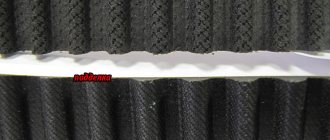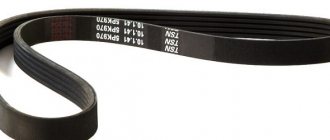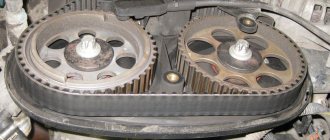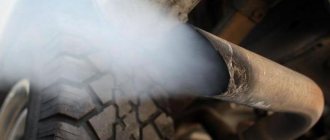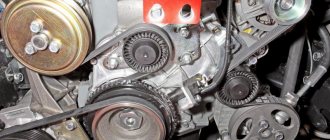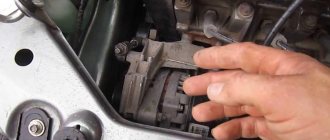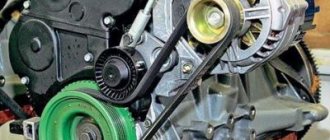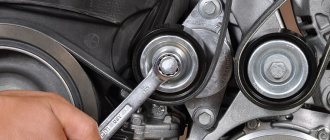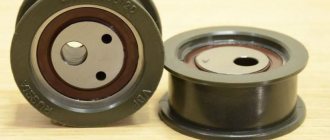The vehicle constantly requires proper care and constant maintenance of its main components. Often malfunctions in car operation are detected based on the sound that is characteristic of certain breakdowns. So, for example, it is easy to determine when the timing belt whistles.
This problem is considered serious for the vehicle as it can lead to critical consequences. A broken belt, as practice shows, can cause major repairs. But the whistle of the gas distribution mechanism is not always associated precisely with its failure. There are several reasons why you should not be afraid of the characteristic sounds of a belt.
Causes of alternator belt whistling
Many drivers refer to a poor-quality purchase of a belt, replace it and everything starts all over again, so before buying a new timing belt, it is better to diagnose the problem by conducting a thorough inspection of the belt drive and, if possible, eliminate it.
Analysis of the conditions under which a whistle usually appears comes down to the following steps:
- the degree of tension is examined (due to weak tension, a characteristic belt creaking often appears);
- the integrity of the entire belt is checked (there is an opinion among car owners that even new products are not always of adequate quality);
- the line of two pulleys is checked for their displacement;
- the cleanliness of the shaft is checked (one of the reasons for the “whistle”).
Product quality
Timing belt whining due to poor quality of the product is the third common reason. It is likely that the belt was purchased at a cheap price; the outer and inner surfaces of the product are of low quality. They have not been reinforced with metal rods well enough or the belt is old, lying in a warehouse.
Obviously, such a belt will function for some time. If you lubricate it, it will not make noise or whistle, but only for a certain time. One way or another, a replacement is needed.
Five main causes of alternator belt whistling
- The condition of the car parts is one of the rules that is important for the vehicle owner to follow - cleanliness of the parts. One of the reasons for a whistling generator belt may be oil that accidentally gets on the belt or shaft. The reason is that the belt loses traction with the surface of the shaft, resulting in it slipping. Removing the belt and removing all traces of oil will most likely solve the problem.
- The cause of whistling may be weak tension and sagging. The solution is quite obvious - you need to look under the hood and check the degree of belt tension. If it is weak, the belt should be tightened.
- The timing belt also squeals due to the incorrect alignment of the pulleys. The pulleys must be strictly in one line, and even a slight slope often leads to squeaking or whistling. To fix the problem, you need to check the degree of displacement and align the pulleys correctly.
- A belt that is too tight can also lead to a characteristic “whistle”, since its rigidity does not allow the pulleys to rotate normally. This situation is quite often observed in the cool season - when the engine warms up, the timing belt regains its shape and the “whistle” disappears.
- A failed bearing often causes an unpleasant sound from the hanging belt. This problem can be solved by replacing it with a new bearing.
The listed reasons are the main and most common among vehicle owners. But there are also other reasons related to the operation of individual car mechanisms. The most important thing is to respond in a timely manner and take measures to eliminate problems.
Phases of the GRS mechanism
The phases of the gas distribution system are precisely what makes the car engine function simultaneously, without disruption. If these very phases go astray, then either the piston will not reach TDC at the right time, or the valve will lag behind, in a word, problems are inevitable.
Article on the topic: Do-it-yourself coilovers, making the suspension adjustable
The phases of the gas distribution system are always set according to the markings, due to which clear and synchronous operation of the motor is achieved.
Phases of the GRS mechanism
If you need to set the timing marks correctly, you will have to remove the belt. You will have to stock up on keys, screwdrivers and all those tools that will make the work easier. For example, a wrench for socket heads - this is convenient for attaching a nut almost anywhere.
Every expert will confirm that the GDS phases must be installed from the factory. But during active operation of the engine, repairs, etc., the phases shift, the car begins to pull poorly and the motor vibrates.
Algorithm for carrying out an operation to diagnose the correctness of marks:
- The top belt protection cover is removed.
- The gearbox switches to 4th.
- The car is pushed forward until the marks on the shaft coincide with the markings on the cover (bottom).
- Now you need to look under the hood.
- Here, find the clutch housing, remove the rubber lock from it, which blocks access to the hole through which the mark on the flywheel is clearly visible.
Note. This mark must necessarily align with the slot in the crankcase shield (it is triangular). If the marks do not match, it means that the phases of the gas distribution system are shifted. If they match, and the risk on the camshaft also matches, you don’t need to do anything.
Timing belt whine when engine is cold
The question of why the alternator belt whistles when cold is of interest to many drivers, and the reason for this is its slipping.
In order to sufficiently spin the generator pulley, there must be a powerful torque from the crankshaft, and there are several reasons for this:
- The wrong lubricant was selected for the generator bearing. In cold weather, due to the significant compaction of its consistency, the generator pulley will not be able to rotate properly until the engine warms up and “unfreezes” the lubricant. Only then will the characteristic whistle stop. The solution to the problem may be to replace the lubricant with an option that is more resistant to low temperatures.
- The alternator belt is not tensioned enough. A similar situation - until the engine starts to work dynamically, a loose timing belt will not be able to “accelerate” to the desired speed on the pulley, it will slip and, as a result, an unpleasant sound will be heard.
Important! Please note that the timing belt can also whistle on a cold engine if there is a serious problem with the generator - this is a jammed pulley.
You can easily diagnose this problem yourself; to do this, you need to try turning the generator pulley. If it does not spin, serious repairs or replacement of the generator will be required.
Step-by-step instructions for eliminating the defect
If noise appears when starting the engine after replacing an element, then there are several ways to eliminate the problem. Each of them will be considered in turn. If the quality of the strap is too low and it is already worn out, then it will need to be replaced; there are no other options. We will not consider this process, since it is individual for each car.
Use the search on our website to find step-by-step instructions for replacing an element for your car. You will find more information about this here. Next, we will look at options for eliminating the problem without removing the strap.
Lubricating the strap
Lubricating the element is one of the solutions to the problem if, after replacing the component, noise appears when starting the engine.
To lubricate the component, you need to purchase a special aerosol, which is sold in any store. In addition, universal WD-40 can be used for these purposes. Naturally, this solution is temporary, but it will only take a few minutes, after which the noise will no longer bother you.
Lubricated tension roller
- Take your aerosol and open the hood of your car.
- Remove the protective cover of the mechanism, which is secured with bolts, using the appropriate wrench.
- Be careful as you will need to start the car for it to work. This will make lubrication more effective. After starting the engine, you will need to aim to ensure that the liquid hits the inner parts of the strap, that is, the teeth. Lubricate the element for five to ten seconds so that the liquid is guaranteed to reach all the teeth.
- Stop the engine and replace the mechanism cover. Enjoy the results.
Belt whistling in rainy and wet weather
Operating a car in conditions of high humidity is often accompanied by a characteristic “whistle”. Moisture, for obvious reasons, gets on the surface of the belt, thereby reducing the frictional ability of the material, and also affects the pulleys. Such sounds are short-term in nature, and this only indicates that the belt has begun to lose elasticity and, if wear allows, it should be tightened.
In humid, damp weather, the frictional abilities of the belt material are significantly reduced. A slipping belt means there is a problem with the belt drive, and wet weather, rain or splashing is simply an indicator that it may need to be replaced soon.
Methods for eliminating noise
The noise that appears immediately after starting the engine can be eliminated in several ways. All of them will be discussed in detail below.
Lubrication
As mentioned above, lubrication of the element, although not for long, eliminates the whistling and noise of the strap. This is the most popular solution to the problem if a whistle appears after installing a new belt.
The lubricant in this case is a special type of aerosol, sold in every store. In addition, the universal VD-40 is also suitable for these purposes.
Step-by-step instructions for lubrication:
- You need to open the hood of the car.
- Remove the protective cover secured with bolts.
- Start the engine.
Note. Lubricating the elements of the hydraulic lubrication mechanism on a running engine is much more effective than on a stationary internal combustion engine. Yes, this will require some skill, which boils down to the fact that you need to be able to aim accurately and get the liquid onto the inner parts of the strap.
- You need to lubricate for 5-10 seconds, so that this time is enough to process all the belt teeth.
- Then you need to turn off the engine, put the cover back in place and check for noise.
Leak and its elimination
The first reason for an oil leak lies in the cylinder head gasket. If it breaks through, it provokes timing belt noise. Surely, if oil or liquid gets on the belt, noise starts.
Consequences associated with belt whistling
A problem related to the alternator belt that is not resolved in a timely manner can subsequently hit the car owner’s budget.
- The first thing that can happen is chronic undercharging of the battery. This will lead to a complete lack of charge and failure of the battery.
- A whistling sound may indicate complete wear of the belt and the possibility of its breakage. If this situation happens outside the countryside, you are unlikely to be able to drive a car.
When the whistle begins to appear, it is best not to tighten the situation and diagnose the tension and general condition of the belt.
Important! If the alternator belt breaks, the engine stops cooling. It is prohibited to drive such a car! Otherwise, the engine will overheat with very dire consequences.
What to do if your belt whistles
If the above reasons for the whistling of the generator belt could not be eliminated and it has not stopped whistling, while it has good tension, the pulleys rotate smoothly and evenly, it is intact and clean, then the problem may be the following: poor quality of the belt itself or in the equipment driving it drives: a generator, tension rollers, an air conditioning compressor, a power steering pump, etc. It is also possible that the grease has simply thickened in the bearings or they have failed.
You can try to temporarily eliminate timing belt whistling using special auto chemicals. Automotive stores offer many products for the prevention and protection of alternator belts. It is recommended to lubricate the alternator belt with conditioner-tensioner to prevent it from whistling to increase its elasticity and prevent cracking. In many cases related specifically to tension or increased wear of the belt, such means can completely get rid of the whistle.
Manufacturers of these fluids recommend applying these products for preventive purposes even before the whistle appears, then the service life of the alternator belt will significantly increase.
Some tips to increase its service life
before and after long-term parking, especially in the warm season, you can slightly “soften” the working area of the belt by lubricating it with a special auto chemical agent (for example, using a conditioner and a Hi-Gear drive belt tensioner) or, in extreme cases, with a gasoline-water solution in a ratio of 1: 2, it will help prevent cracking;
protect the belt during routine maintenance, make sure that there are no electrical wiring, clamps, or rags near it;
after driving for a long time on a dusty road, use a compressor to blow through the rotation area of the alternator belt;
check the degree of tension at the beginning of each season: summer, autumn and beyond;
in severe frosts, be sure to check the tension, because... excessive tension can lead to its irreversible stretching and premature failure;
If you are putting your car into hibernation for the winter, loosen the tension for the winter period.
Video - how to eliminate the whistling of the alternator belt when the engine is cold:
May be of interest:
Scanner for self-diagnosis of a car
Compare the cost of MTPL for your car
Choose a DVR: an indispensable gadget for the driver
Some drivers prefer a DVR in the form of a mirror

